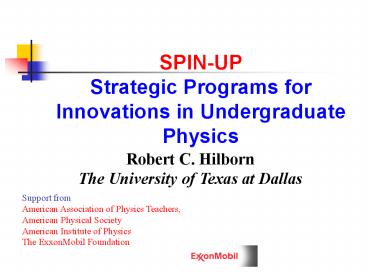SPIN-UP - PowerPoint PPT Presentation
1 / 22
Title:
SPIN-UP
Description:
S. James Gates (U. Maryland) Robert Hilborn (UT Dallas) ... Harvard University. University of Illinois. University of Wisconsin-LaCrosse. Lawrence University ... – PowerPoint PPT presentation
Number of Views:74
Avg rating:3.0/5.0
Title: SPIN-UP
1
SPIN-UP Strategic Programs for Innovations in
Undergraduate Physics
Robert C. Hilborn The University of Texas at
Dallas
Support from American Association of Physics
Teachers, American Physical Society American
Institute of Physics The ExxonMobil Foundation
2
Outline
- Why do some programs thrive lessons from
SPIN-UP 2002. - What has happened since.
- Take home messages.
3
Recent Physics Bachelors Degree Production
2006
Source AIP Statistical Research Center
Enrollments and Degrees Report, and NCES Digest
of Education Statistics
4
National Task Force on Undergraduate Physics
(2000-2006)
SPIN-UP Strategic Programs for Innovations in
Undergraduate Physics
5
National Task Force on Undergraduate Physics
(2000-2006)
Laurie McNeil (U. North Carolina-Chapel
Hill) Jose Mestre (Illinois) Tom OKuma (Lee
College) Doug Osheroff (Stanford) Joe Taylor
(Princeton) Carl Wieman (U. Colorado, U.
British-Columbia)
J. D. Garcia (U. Arizona) S. James Gates (U.
Maryland) Robert Hilborn (UT Dallas), Chair Ruth
Howes (Marquette), Co-Chair Ken Krane (Oregon
State) Liz McCormack (Bryn Mawr)
Ex Officio AIP- J. Stith, J. Hehn APS-J. Franz,
T. Hodapp AAPT-B. Khoury, W. Hein PKAL J. Narum
6
SPIN-UP
- Site Visits to 21 thriving undergraduate
physics programs. - Survey (with AIP) of all 761 bachelors
degree-granting physics programs in the US (74
response). - Report and Analysis. 2002-2003
What do we mean by thriving?
7
Site Visit Departmentsvisits carried out by 65
physics volunteers Task Force members
- Angelo State University
- University of Arizona
- Bethel College
- Brigham Young University
- Bryn Mawr College
- Colorado School of Mines
- Cal State San Luis Obispo
- Carleton College
- Grove City College
- Harvard University
- University of Illinois
- University of Wisconsin-LaCrosse
- Lawrence University
- North Carolina State Univ.
- North Park University
- Oregon State University
- Reed College
- Rutgers University
- SUNY Geneseo
- University of Virginia
- Whitman College
8
(No Transcript)
9
Essential Findings for Thriving Undergraduate
Physics Programs
- The department is the crucial unit for change.
The department must own the undergraduate
program. - The program is more than courses.
- Change takes time and energy (but not necessarily
a lot of money) and is an on-going process.
10
What Makes an Undergraduate Physics Program
Thrive? Physics Today, September, 2003
- Strong and sustained departmental leadership.
- Well-defined sense of mission (correlated with
mission of the institution). - Emphasis on the entire program of the department,
large fraction of the faculty engaged.
11
What makes an undergraduate program thrive?
- A widespread attitude among the faculty that the
department has the primary responsibility for
improving the program not a bunch of whiners - A challenging but supportive program with many
opportunities for student-faculty interactions - Continuous evaluation and experimentation
- Strong and sustained leadership (worth mentioning
again)
12
Details
- Recruit and retain students
- Challenging and supportive program
- Career information - alumni
- Introductory courses
- Prof. development and mentoring
- Multiple-tracks/options
- Research experiences early and often
13
What is not on the list?
- Major interdisciplinary efforts (except through
multiple-tracks) - Radically different curricula
- Watered-down curricula
- Extraordinary use of IT almost everybody uses
some no big deal - Lavish new buildings and equipment
14
The SPIN-UP Reportand Departmental Guidelines
Report http//www.aapt.org/Projects/ntfup.cfm
AAPT Guidelines for Self-Study and External
Evaluation of Undergraduate Physics Programs
15
Consulting Site Visits
- Available upon request
- Department pays travel and local expenses
- Contact Bob Hilborn
- rhilborn_at_utdallas.edu
16
What has happened since the SPIN-UP study?
- Data from departments that have had large
increases in the number of undergraduate physics
majors since 2000. - Average 1997-1999
- Average 2003-2005
- N gt 15 in 2005
17
Top Increases1997-99 -gt 2003-05Research
Universities (Ngt15 for 2005)
18
Primarily Undergraduate Institutions (N gt 15 for
2005)
19
Why Isnt Every Program Thriving?
- Melba Phillips The problem with physics
education problems is that they dont stay
solved. - Albert Einstein We cant use the same kind of
thinking to solve problems as we did when we
created them. - John Russell All reform is ultimately local.
20
Sustaining Enhancements
Individuals, departments, institutions,
disciplines
21
Other Connections
- Sheila Tobias, Revitalizing Undergraduate
Science Why Some Things Work and Most Don't
(1992) - Mathematical Association of America
- Models that Work Case Studies in Effective
Undergraduate Mathematics Programs (1995) - Jim Collins, From Good to Great (HarperCollins,
New York, 2001)
22
Take Home Messages
- SPIN-UP provides 21 existence proofs that real
physics departments can build thriving programs.
Many more since then. - There are several models of successful programs.
(Build on local strengths.) One size does not fit
all. - Meaningful change requires that you understand
your entire undergraduate program and your
students and keep working.







![Top 5 Tennis Strings for Spin 2021 [Reviewed] PowerPoint PPT Presentation](https://s3.amazonaws.com/images.powershow.com/9683536.th0.jpg?_=202111150212)























